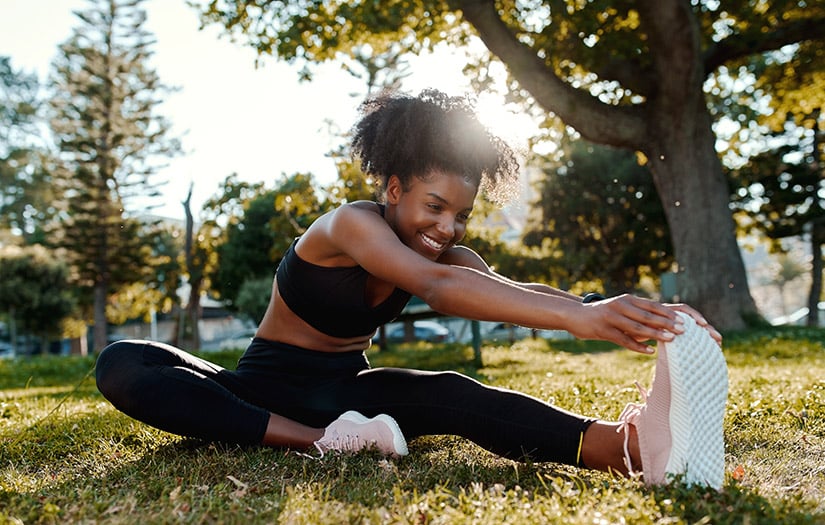A regular stretch routine has many benefits. Stretching will help you increase your flexibility, move better overall, and it’s also a great way to de-stress. As a beginner, it’s great to start with basic stretches that don’t require any crazy contortions or weird positions to try to figure out.
In this article, you’ll learn a full body stretch routine and some tips and tricks for how to implement this routine into your lifestyle for the best results. You can learn more on this topic within the NASM Stretching and Flexibility Certification course, but we will cover the basics right here!
10 best Stretches for Beginners
- Standing Calf Stretch
- Standing or Seated Inner Thigh Stretch
- Standing or Seated Hamstrings Stretch
- Quad Stretch
- Kneeling or Standing Hip Flexor Stretch
- Standing Lat Stretch
- Standing Chest Stretch
- Standing or Seated Traps Stretch
- Standing or seated levator scapulae stretch
- Thoracic Spine Stretch
You’ll notice that many of these stretches have options for kneeling, sitting, or standing. Choose the option that works best for you! You don’t have to get down on the ground to get a good stretch! Plus, standing or seated stretches are office friendly.
For each of these stretches, ease into the stretch position until you start to feel the stretch. Once you start to feel a tolerable stretch, hold still in that position for 30 seconds, up to 2 minutes, depending on your goals and your available time. Remember to breathe as you stretch, and try to relax.
Standing calf stretch
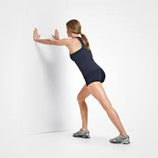
Place your hands on a wall or fixed surface and step back with one foot.
Turn the toes of your back foot inward slightly and press your heel into the ground to feel a stretch in the calf of the back leg.
Bend the front leg more for a deeper stretch, or move the back leg back until you feel a good stretch.
Standing or seated inner thigh stretch
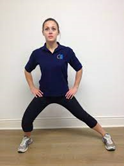
Standing: Stand with feet wider than hip width apart and toes facing straight ahead.
Lunge to one side by bending the knee and sitting the hips back, keeping the other leg straight.
You should feel a stretch in the inner thigh of the straight leg.
Seated: Sit on a ball or in a chair with one leg bent and the other straight out to the side (just like the standing inner thigh stretch).
Shift your weight toward the bent leg until you feel a stretch in the inner thigh of the straight leg.
Standing or seated hamstrings stretch

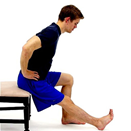
Standing: Place one heel out in front, with your toes up, and keep that leg straight as you sit your hips back like you’re sitting in a chair.
You should feel the stretch in the back of the straight leg.
Seated: Sit on the front edge of the seat with both legs bent in front of you.
Extend one leg straight out, with the toes up, and keep your back flat as you lean forward to feel the stretch in the back of the straight leg.
Standing or lying down quad stretch
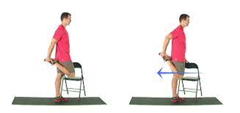
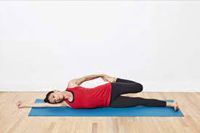
Standing: Hold onto a chair, wall, or counter top for balance as you bend one knee and grab the foot behind you.
Squeeze your glutes and bring your stretching leg back until your thighs are even.
You should feel the stretch on the front of the thigh on the bent leg.
If this stretch is too intense, put a towel or band around your foot and gently pull the towel or band up toward your glutes to allow your knee to bend as far as you can to feel a comfortable stretch.
Lying Down: Lay down on one side and bend the top leg.
Grab your foot with the top arm and pull your thigh back until it’s stacked right on top of the other one. You should feel a stretch on the front of the thigh of the bent leg.
If this stretch is too intense, put a towel or band around your foot and gently pull the towel or band up toward your glutes to allow your knee to bend as far as you can to feel a comfortable stretch.
Kneeling or standing hip flexor stretch
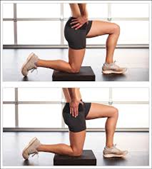
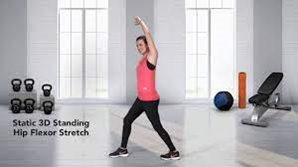
Kneeling: Place one knee directly underneath the hip and the other leg bent at 90-degrees with the foot flat on the ground. This is a half-kneeling position.
Squeeze the glutes on the kneeling side and tuck the hips under.
You should feel the stretch on the front of the hip and the front of the thigh of the kneeling leg.
Standing: Step one foot back with both feet facing straight ahead.
Raise the arm on the same side as the back leg. Reach up and over your head slightly. You can also rotate your upper body away from the front leg slightly to deepen the stretch.
You will feel the stretch on the front of the hip of the back leg.
Standing lat stretch

You can use a chair, countertop, or any surface of a similar height.
Place one or both hands on the surface, and bend at the waist while you press your chest down toward the ground.
Keep the hips tucked under and the abs tight to avoid arching the back.
You should feel the stretch under the arm and along the side of your ribs.
Standing chest stretch
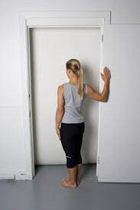
Bend your elbow to 90-degrees and place your forearm on a doorway or wall with the elbow at or just below shoulder height.
Step forward slightly to feel a stretch across the chest and shoulder of the arm on the wall.
Standing or seated traps stretch
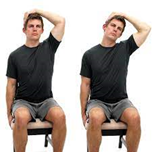
This stretch can be done seated or standing.
Sit up tall, with your shoulders down and pulled back and your ears stacked over your shoulders.
Place one hand on top of your head and very gently pull your ear to the side toward your shoulder.
You should feel this stretch in your traps- where most of us feel tension in the neck.
Standing or seated levator scapulae stretch
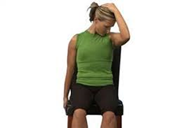
This stretch can be done seated or standing.
Sit up tall, with your shoulders down and pulled back and your ears stacked over your shoulders.
Place one hand on top of your head with your nose and elbow in line. Gently pull your nose down toward your armpit.
You’ll feel this stretch from the base of your head, and in the neck, down to the top of the shoulder blade.
Kneeling or standing thoracic spine stretch

Kneeling: Get on all fours, tighten the abs, and place one hand behind your head.
Exhale and reach the elbow of the bent arm toward the opposite armpit, and then inhale as you bring the elbow up toward the sky.
It will look like you’re rotating your elbow down and then up to stretch the upper back.
Instead of holding this stretch, do 5-8 slow repetitions of rotating down and up before switching sides.
It’s OK if you can’t reach your elbow very high- don’t force it!
Standing: Same motion, but you’ll stand with one hand on the seat or back of a chair. Remember to keep your knees slightly bent in this position and start with your back flat!
How Do You Start Stretching for Beginners?
As with any new routine or habit, start with a small goal and gradually build up. Decide when and where you want to stretch. For example, do you want to stretch each time you exercise or go to the gym? Or maybe you‘d like to incorporate stretching into your wake-up or bedtime routine. You can decide when it will fit in best during your day. I even have clients who like to do some of these stretches at the office as a desk break! You can decide what will work for you.
How much time do you want to dedicate to stretching? This will determine how many stretches you do and how long you’ll hold each stretch. You can do the whole routine of 10 stretches in about 10-15 minutes if you hold each stretch for 30 seconds. If you have less time available, you can pick the 3-5 stretches that feel the best to you. All of these stretches are great, but if you had to prioritize, I would target the calves, inner thigh, hip flexors, pecs, and levator scapulae. These tend to be trouble spots for most people due to extended sitting time.
Once you know when and where you would like to stretch, there are a couple of ways that you can implement stretching into your routine. The first option is to choose one stretch to do each day. When you’re consistent with that, you can add another stretch or two to your daily routine and then keep building until you’re doing all of the stretches you’d like to do.
The second option is to start by doing your full stretch routine once or twice a week. Schedule it on your calendar and commit to this schedule. Once you’re doing it regularly (for 2-4 weeks), you can add more stretch days as you see fit.
How Often Should You Stretch as a Beginner?
At least 2-4 days of stretching per week are ideal if you want to see a noticeable difference in your flexibility. With stretching, consistency, frequency, and the length of the stretch do matter.
If you’re looking to increase your flexibility, it’s beneficial to hold a longer stretch (1-2 minutes) and to stretch at least 3 days a week. As a beginner, you can start with 2 times per week and then add more days as you get comfortable with the routine.
What Stretches Can You Do Everyday?
All these stretches can be done daily, and you will notice improvements in your flexibility by stretching more regularly. If you have a desk job or spend most of your day seated (like most people), there are some stretches that you can do periodically throughout your day to improve your posture and reduce low back pain.
Get up each hour or so to do the standing calf stretch, standing hip flexor stretch, and standing chest stretch. Alternatively, you can pick a different stretch from the list above to do each hour to break up your workday. The more you move, the better you’ll feel!
Is it Bad to Stretch Every Day?
No! There’s no risk in stretching every day unless you’re stretching too far. When you sink into a stretch position, you want to stop when you begin to feel the tension. If you experience pain or the stretch is extremely uncomfortable, you might be stretching beyond your body’s capability.
If this happens, stop and reposition to find the spot where you feel tension in the stretch. Also, if you have an injury, you will want to check with your physician before starting a stretch routine to ensure that the stretching is helping and not harming.

